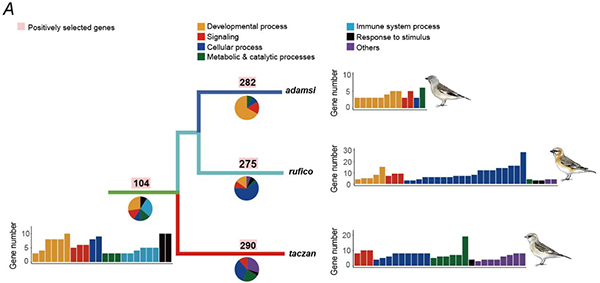Ever since the era of Darwin, adaptive evolution has been a cornerstone of evolutionary biology. One essential related question is do animals adapt similarly to a shared environments? Indeed, scientists have long ago observed that animals usually evolve similar phenotypes in similar environments, and thus formulated classic ecogeographical rules, as e.g., “Bergmann's Law”, “Allen's Law”, and “Gloger's Law”. Specifically, animals in high-elevation environments with low temperature, low oxygen, and strong UV radiation often evolve larger body size and rounder body shape (in agreement with “Bergmann's Law” and “Allen's Law”), as well as darker skin color (in agreement with “Gloger's Law”) than their lowland relatives. These discoveries have led to a long-term hypothesis that adaptive evolution of phenotype to similar environments is convergent to a high degree.
However, contrary to the observations of convergence in phenotypic adaptations, the boom of genomic studies in the last twenty years have shown that genetic adaptations of animals living in similar environments often differ. In particular, the genes or amino acid sites that are functionally relevant to the phenotypic adaptations vary between species. Given that genetic adaptations rely heavily on the available inherited variation, it is therefore essential to address if species sharing a common ancestry evolve similar genetic adaptations.
On March 22, 2021, a research entitled “The evolution of ancestral and species-specific adaptations in snowfinches at the Qinghai–Tibet Plateau” was published in PNAS. The research team led by Drs. Fumin Lei, Yanhua Qu, and Yong E. Zhang from the Institute of Zoology (IOZ) of the Chinese Academy of Sciences, in collaboration with BGI, have addressed this issue in an avian group, a snowfinch complex. This complex is one of very few avian groups that have diversified “in situ” in the high-elevation environments of the Qinghai-Tibet Plateau (QTP). Using an integrated approach combining ancestral phenotypic reconstruction, comparative genomics and funcitonal assays, they described a novel case of adaptive evolution in which the descendants have evolved similar but not identical evolutionary trajectories to adapt to the extreme high-elevation conditions.
Unlike most other members of the avain family Passeridae, which are mainly distributed at low elevations, the snowfinches constitute an adaptive radiation to the high elevations in the QTP. Using the lowland relatives as the outgroup, the researchers reconstructed ancestral phentoypes and found that the ancestor of snowfinches was already adapted to high-elevation environments and also had a larger body mass than its closest relatives in the lowland (Figure 1).

Figure 1. Reconstruction of ancestral traits (elevation and body mass) for species of the family Passeridae. Green curve lines indicate snowfinches. (Image by IOZ).
Researchers then carried out comparative genomics and functional experiments using representatives of the three major clades of snowfinches. They demonstrated that the genetic background of the common ancestor only partly constrained the adaptive diversification of the three snowfinch species. That is, by searching the signals of positive selection, they found that only a dozen positively selected genes in the ancestor branch continued to be subjected to positive selection in the three descendants, but two of the three species (adamsi and rufico) are significantly similar to their ancestor in terms of biological functions of the positively selected genes (Figure 2).

Figure 2. Functional enrichments of positively selected genes for the ancestor and each of the three species of snowfinches. Two species (adamsi and rufico) exhibit high levels of functional similarities to the ancestor. (Image by IOZ)
A striking example of positively selected gene is a DNA repair gene, DTL. Although the DNA damage repair capacities was improved by amino acid changes in both the snowfinch ancestor and its descendants compared to lowland control bird (tree sparrows or montan), the repair kinetics differed across the ancestor and the three descandants (Figure 3).

Figure 3. A schematic representation of the functional experiment with DTL. The repair kinetics of DNA damage varies across the ancestral and descendant snowfinches. (Image by IOZ)
Adaptation in different animals to the same environment is often achieved through similar phenotypic solutions. However, this study indicates that genetic adaptations follow more complex trajectories. That is, the common developmental and genetic architecture inherited from the ancestor together with microhabitats unique to each species shapes similar but not identical evolutionary trajectories.
This research was funded by grants from the Second Tibetan Plateau Scientific Expedition and Research Program, the Strategic Priority Research Program of the Chinese Academy of Sciences, the National Science Foundation of China. The original paper can be accessed at: (https://doi.org/10.1073/pnas.2012398118).
(Contact: leifm@ioz.ac.cn)



